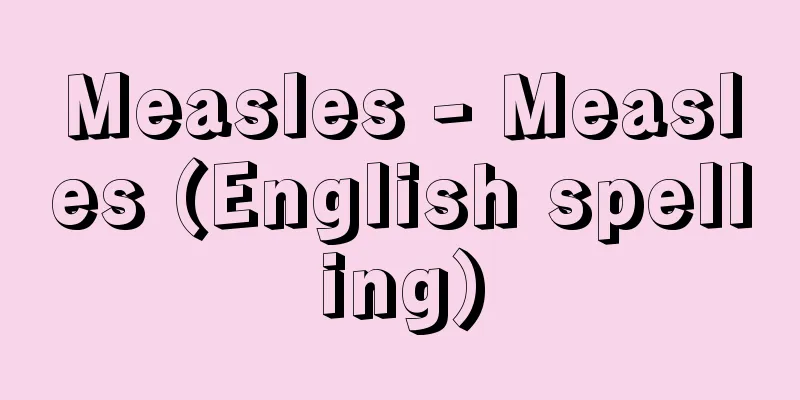Measles - Measles (English spelling)

What is the disease?What is the cause?The measles virus is responsible, and it can be transmitted through the air, even if you are far away from a child with measles. How symptoms manifestThe incubation period is 10 to 12 days, and the onset of symptoms is fever and catarrhal symptoms (cough, runny nose, excessive tearing). Figure 46 shows the clinical course, which is divided into three stages: the catarrhal stage (prodromal stage), the rash stage, and the convalescent stage. The catarrhal stage lasts for 2-3 days, during which there is strong viremia (a large amount of measles virus in the blood), and the virus spreads throughout the body during this period. Symptoms include fever, sneezing, runny nose, coughing, The rash stage lasts for 3-4 days and is a period of skin infection and inflammation caused by the virus. At the end of the catarrhal stage, the fever temporarily subsides and then begins to rise again, at which point the rash appears (Figure 47). The rash begins behind the ears and spreads to the face, trunk, and limbs. During this stage, the high fever continues and the cough becomes even more severe. The fever will continue for about a week, then the patient will enter a convalescent phase. The rash will fade in the order in which it appeared, leaving brown pigmentation. Many of the abnormal progressions and complications of measles are serious, including internal measles (no rash appears, and lesions are only inside the body), hemorrhagic measles, encephalitis, etc. Common complications include otitis media, pneumonia, and laryngitis. Testing and diagnosisThe peripheral white blood cell count is significantly decreased. Measles is not difficult to diagnose without testing. Contact with a measles patient 10-12 days prior, watery eyes, and a strong cough are also indicators. Pediatricians will diagnose the condition by checking for Koplik spots before the rash appears. To distinguish between rubella, exanthema subitum, Treatment and prevention methods There is no specific cure for the measles virus. If your child develops the disease, you should of course see a pediatrician, but rest, fluid and nutrition, fever reducers, If you have been in contact with a measles patient within 6 days Currently, the measles vaccine is administered as a combined measles-rubella (MR) vaccine, which is administered twice in total, at the first stage (for children aged 1 year) and the second stage (for children in the year before entering elementary school). This is because immunity does not last long after a single vaccination, so the second vaccination is administered to strengthen immunity and prevent contracting measles or rubella in adulthood. From April 1, 2008, for a period of five years, the target population for measles and rubella vaccinations will be expanded to include the third series (age equivalent to first-year junior high school students) and the fourth series (age equivalent to third-year high school students). This means that children who missed the opportunity and only received one vaccination will be able to receive a second vaccination. Measles is a highly contagious and serious disease with many severe complications, so it is important to receive the measles vaccine. What to do if you notice an illnessYou should immediately take your child to a pediatrician. The fever will last for about a week. This is a particularly debilitating illness, so be careful to avoid dehydration and other complications. Your child cannot attend school or daycare until three days have passed since the fever subsided. Kizo Asano "> Figure 46. Clinical course of measles "> Figure 47. Measles rash and wasted facial appearance Source: Houken “Sixth Edition Family Medicine Encyclopedia” Information about the Sixth Edition Family Medicine Encyclopedia |
どんな病気か 原因は何か麻疹ウイルスが原因で、麻疹患児から離れたところにいても、うつってしまいます(空気感染)。 症状の現れ方潜伏期は10~12日で、発熱、カタル症状(咳、鼻みず、涙がたくさん出る)で発症します。図46に臨床経過を示しますが、病期をカタル期(前駆期)、発疹期、回復期の3期に分けます。 カタル期は2~3日で、強いウイルス血症(血液中に麻疹ウイルスがたくさんいる)があり、ウイルスはこの時期に全身に広がります。発熱、くしゃみ、鼻汁、咳、 発疹期は3~4日で、ウイルスによる皮膚の感染と炎症の時期になります。カタル期の終わりに熱が一時下がり、また上がり始める時に発疹が現れます(図47)。発疹は耳後部から始まり、顔面、胴体、四肢に広がります。この時期は高熱が続き、咳もさらに強くなります。 熱が約1週間続いたあと、下降し回復期に入ります。発疹は現れた順に退色し、褐色の色素沈着を残します。 麻疹の異常経過や合併症には重いものが多く、麻疹の内攻(発疹は現れず、病変が体内だけにある)、出血性麻疹、脳炎などがあります。頻度の高い合併症として中耳炎、肺炎、喉頭炎などがあげられます。 検査と診断末梢血の白血球数がかなり少なくなります。麻疹の診断は検査をしなくても難しくありません。麻疹患者との接触が10~12日前にあり、潤んだ目や咳がかなり強いことも参考になります。小児科医はコプリック斑を確認し、発疹が現れる前に診断します。 区別するものとして、風疹、突発性発疹症、 治療、予防の方法 麻疹ウイルスの特効薬はありません。発病したらもちろん小児科医にかからなければなりませんが、安静、水分と栄養補給、解熱薬、 麻疹患者に接触しても6日以内であれば 現在、麻疹ワクチンは麻疹・風疹混合(MR)ワクチンとして接種、第1期(1歳児)と第2期(小学校入学前年度の1年間にあたる子)に計2回接種します。これは1回の接種では免疫が長く続かないため、2回目を接種し免疫を強め、成人になってから麻疹や風疹にかからないようにするためです。 2008年4月1日から5年間の期限付きで、麻疹と風疹の予防接種対象が、第3期(中学1年生相当世代)、第4期(高校3年生相当世代)にも拡大され、接種機会を逸し1回しか接種されていない子も2回接種が可能になります。 麻疹は伝染力が強く、重い病気で、合併症も重いものが多いため、麻疹ワクチンの接種を受けることが大切であることを強調しておきます。 病気に気づいたらどうするすぐに小児科を受診する必要があります。熱は約1週間続きます。とくに消耗の激しい病気ですから、脱水や合併症には注意してください。解熱後3日を経過するまでは登園、登校はできません。 浅野 喜造 "> 図46 麻疹の臨床経過 "> 図47 麻疹の発疹と消耗した顔貌 出典 法研「六訂版 家庭医学大全科」六訂版 家庭医学大全科について 情報 |
<<: Bashi Channel - Bashi Channel (English)
Recommend
Production relations (English spelling)
The social relations that humans form with each ot...
Abnormal hearing range - Ijyouchouki
A volcanic eruption is a volcanic explosion that o...
Disc Gauge - Enban Gauge
...the end surface is either flat, cylindrical, o...
Intermediate fiber
...The transformation of cancer cells into round ...
Sign - Fugo
〘noun〙① A sign. A mark used to check the relations...
Oba Kageyoshi - Oba Kageyoshi
Year of death: 4/4/9 (1210.5.3) Year of birth: Yea...
Side dance - gawaodori
...In the Edo period, the idea of amazed people...
Kauri Copal
Kauri gum is a type of natural resin found in copa...
Mashiko ware
Pottery kilns and their products in Mashiko Town,...
Bunka and Bunsei era
This was a period under the rule of the eleventh T...
World Weather Watch Program; WWW
The World Meteorological Organization (WMO) began ...
Homicide - Tasatsu
A concept of suicide, generally referring to the a...
Eutectoid transformation
The magnetic transformation is a process that cha...
Umbrella Crossing - Umbrella Crossing
...The number of events increased as it was passe...
Tokunaga Sunao - Tokunaga Sunao
Novelist. Born in Kumamoto Prefecture on January ...









